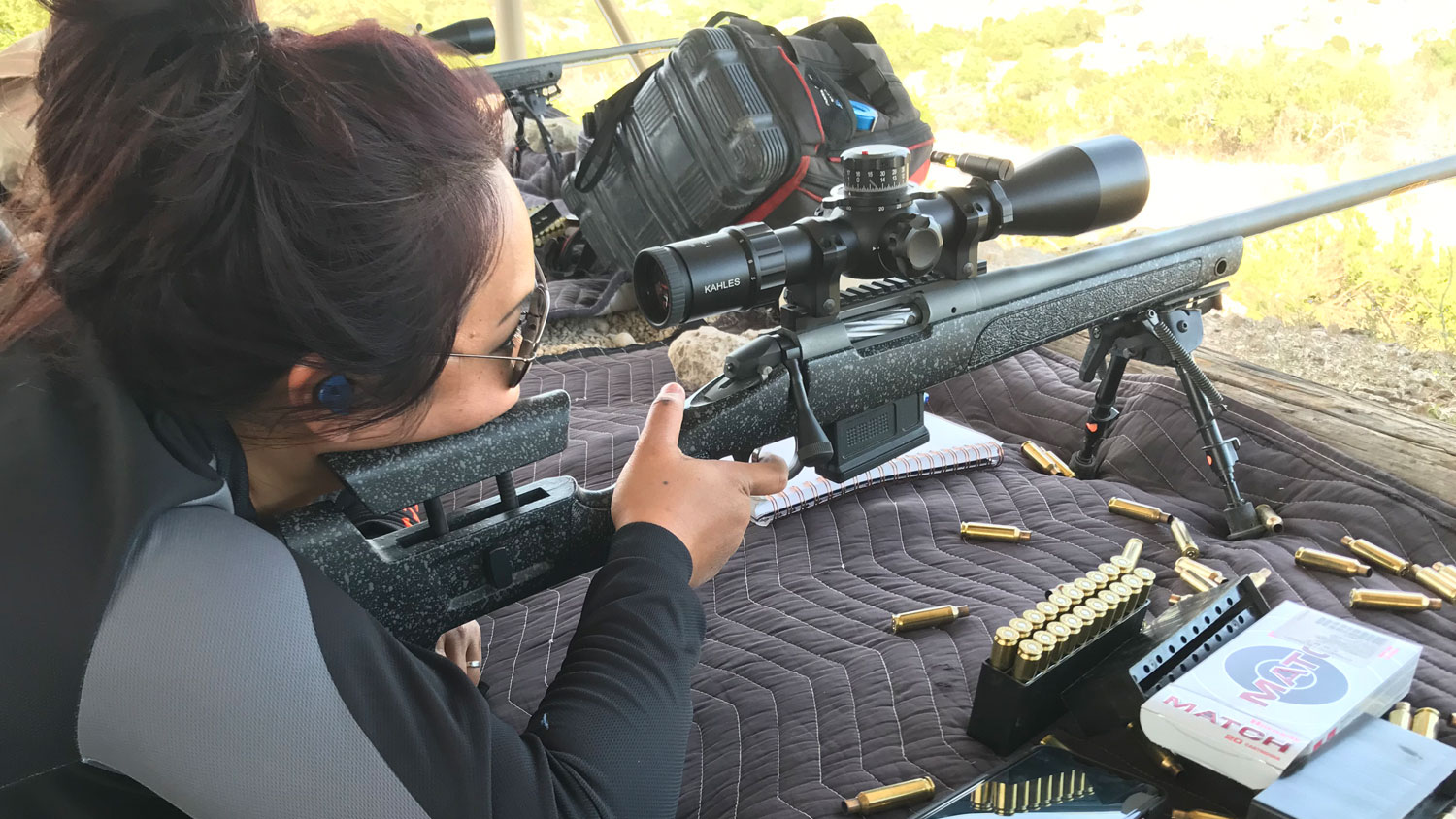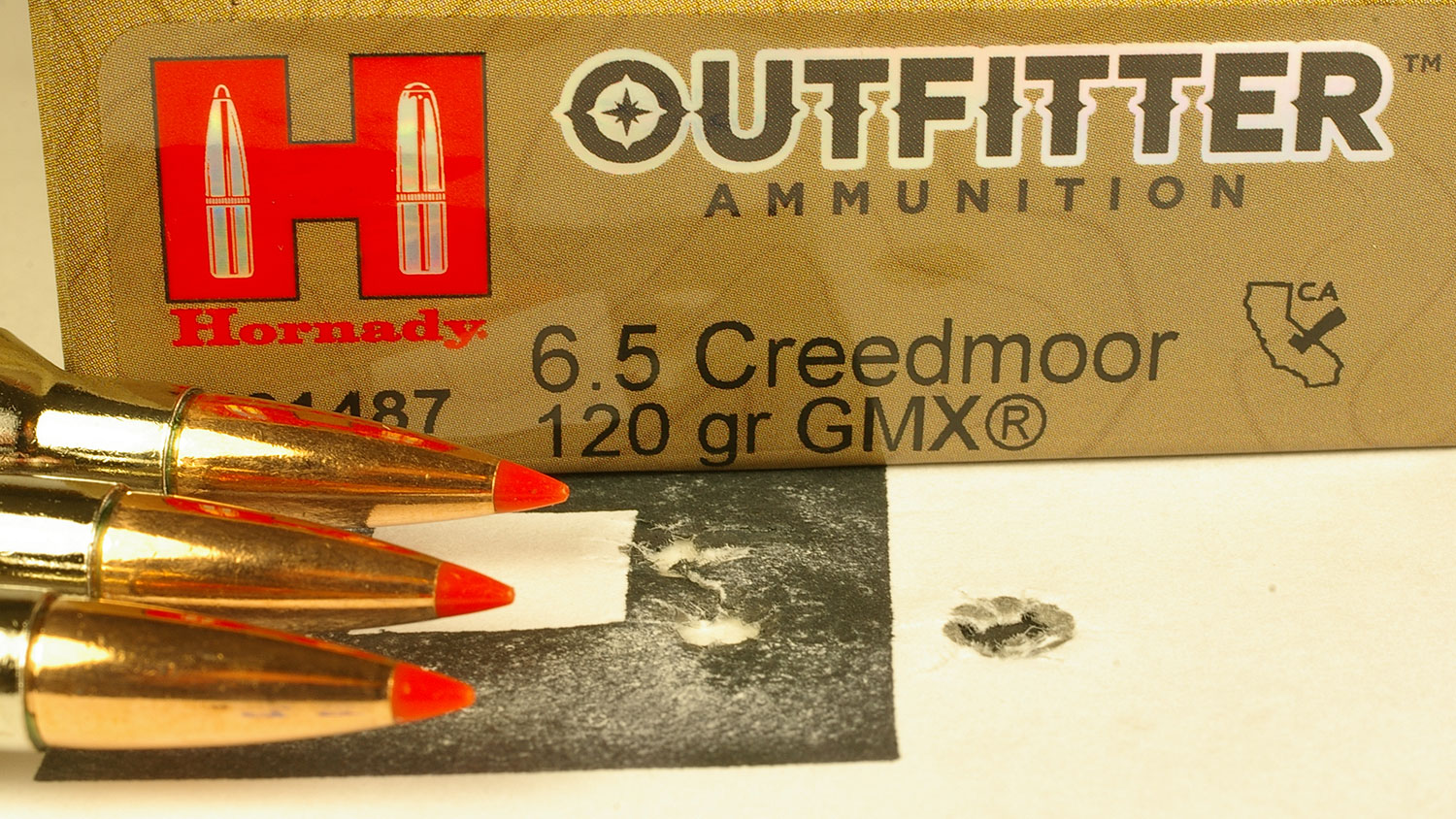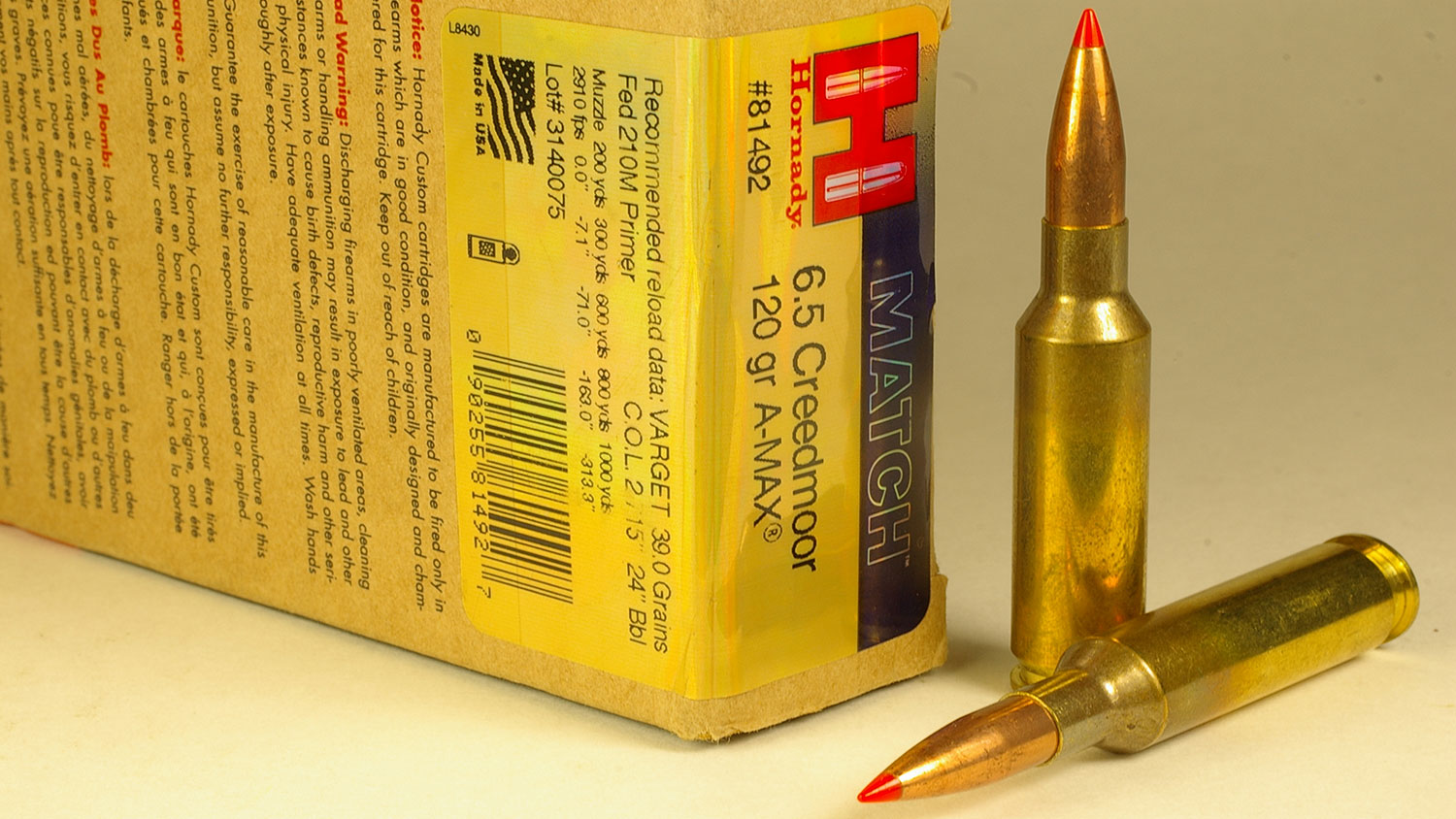
Above: (from l.) Browning 120-gr. BXS, Hornady Outfitter 120-gr. GMX, HSM Tipping Point 130-gr. Sierra Tipped GameKing, Hornady Superformance 129-gr. SST, Norma Professional Hunter 130-gr. Swift Scirocco II, Sierra GameChanger 130-gr. Tipped GameKing, Swift High Grade 130-gr. Scirocco II, Remington High Performance 140-gr. BTHP and Black Hills Gold 143-gr. ELD-X.
Partially by luck and some by design, the 6.5 Creedmoor is the perfect blend of all the pluses that makes a product successful in the market. One benefit of the 6.5 Creedmoor is a streamlined bullet that produces a flat bullet trajectory as an alternative to ever-larger cartridges relying on sheer propellant muscle. The Creedmoor was initially intended as a target cartridge, and it’s a great one. However, its mass appeal is to hunters. Its ever-growing popularity has resulted in an abundance of factory cartridges and rifles. Helping the 6.5 Creedmoor along the way have been credible testimonials and proven results from shooting experts and the media, and perhaps more than a little hype.

Recoil Weary
Close to the turn of the current century new cartridges relied on the muscle of propellant to produce a flat trajectory. Some cartridges in point include the .30-378 Weatherby Magnum (1996) and .300 Rem. Ultra Magnum (1999) and all their attendant recoil. Those cartridges and others fired bullets with no especially high ballistic coefficients (BC) to efficiently pierce the air or resist the wind. When Americans did consider high BCs, they thought of 7mm bullets and the ever-present 7mm Rem. Magnum. Quite a few new cartridges exploited the 7mm’s popularity, culminating with the 7mm Rem. Ultra Magnum in 2001.
These cartridges collectively led to recoil-weary shooters and hunters. In a search for agreeable cartridges to shoot targets in the off-season, many rifle shooters shifted to mild and efficient cartridges. Twenty years after its introduction, the 7mm-08 Rem. became a favorite. The .260 Rem. also had its admirers. With perfect timing in 2008 came the 6.5 Creedmoor and began its meteoric ascent in popularity.

Bullets fired from these three cartridges fail to develop as flat of a trajectory as large magnum cartridges do. However, these mild cartridges arrived concurrently with the widespread use of laser rangefinders to determine exact distance to targets, along with scopes incorporating reticles with a series of hash marks on the lower wire, and/or elevation and windage turrets made to dial to compensate for bullet drop and drift. You no longer need a cartridge to fire bullets with a lean trajectory to hit distant targets. The mechanical adjustment of a scope replaced the chemical reaction of burning a large amount of propellant. Suddenly, the 2700 fps the Creedmoor fired 140-grain bullets was the new 3100 fps past cartridges fired bullets.
Bullets
Repeatedly we are told the 6.5 Creedmoor is all about high BC bullets. The Creedmoor is Hornady’s creation, so let’s look at a couple of its 6.5 bullets. The 143-grain ELD-X bullet sports a G1 .625 BC and 140-grain ELD Match a .620 BC. About 10 to 20 grains of additional weight is required for .27-cal. and 7mm-cal. bullets to equal the BC of those 6.5 bullets. Thirty cal. bullets require 50 to 60 grains of extra weight to match the BC of the 6.5 bullets. So, the Creedmoor attains the same trajectory with less recoil than larger-caliber cartridges that require more propellant burning to fire their bullets at the same speed as the Creedmoor. Consider too, the additional recoil generated by the heavier bullets.
Primarily due to the Creedmoor’s popularity, all manner of 6.5 bullets have been introduced in recent years in factory cartridges and for handloading. Target bullets include Berger VLD, Cutting Edge MTAC, Hornady ELD Match and A-Tip, Norma Match, Nosler RDF and Custom Competition and Sierra Tipped MatchKing. You’ll find lead-core hunting bullets comprise Hornady InterLock, SST and ELD-X, Nosler Ballistic Tip and AccuBond, Sierra GameKing and Tipped GameKing, Swift A-Frame and Scirocco. Lead-free bullets take in the Barnes Tipped Triple Shock, Browning BXS, Cutting Edge Raptor, Hornady GMX and Nosler E-Tip. All those bullets are only a sample.

Factory Cartridges
Most of those bullets and others are loaded in factory 6.5 ammunition. I tried counting all 6.5 Creedmoor factory loads, but all the adding made my head hurt. Instead, I’ll say MidwayUSA lists 53 factory loads for the 6.5 manufactured by 16 companies from Atomic and Black Hills to Swift and Winchester. In comparison, Midway lists 130 factory loads for the .308 Win., 105 for the .30-06 Sprg. and 54 for the .270 Win.

The chart at the bottom of this article lists nine of those 6.5 factory loads. Accuracy of five of the loads averaged under an inch at 100 yards for three, three-shot groups. That is better than good from an inexpensive rifle like the Ruger American Predator. Hunting Shack Munitions (HSM) Tipping Point loads averaged 1.59 inches, which was kind of odd because Sierra GameChanger cartridges are loaded with the same Sierra 130-grain Tipped GameKing bullets and they averaged .74 inch. Out of curiosity, I shot the HSM load at 200 and 300 yards. The bullets averaged 1.37-inch groups at 200 yards and 2.43 inches at 300 yards, which was heartening—but still odd.
For my shooting over the years, the .223 Rem. and .22-250 Rem., .300 WSM and perhaps the .308 Win. are the only other rifle cartridges that have shot that well across the board with factory ammunition.
I’ll throw this idea up in the air to see if it flies—Creedmoor factory ammunition is very accurate because the cartridge is relatively new, which has resulted in uniform dimensions. The cartridge is not proprietary to Hornady. So, any ammunition company can join in, and perhaps slightly improve the cartridge along the way with new bullets and new propellants.

I checked the bullet runout of five of the 6.5 factory loads listed in the chart with a Hornady Lock-N-Load Concentricity Tool. The 120-grain GMX bullets in Hornady Outfitter cartridges varied at the most .003 inches from straight. Bullets in Browning, Norma, Remington and Sierra cartridges were perfectly straight to .002 inches from straight.
I thumbed through my records on four Creedmoor rifles. Rarely did a factory load produce an extreme spread of velocity more than 50 fps. Extreme spreads of velocity mostly ranged from four to 35 fps for nine shots. That shows factory cases are uniform in weight and propellant capacity with necks applying consistent tension on bullets, and bullets seated to hold propellant charges firmly in place to produce an even burn.

Rifles
Rifles chambered in 6.5 Creedmoor are available for every budget and preference. CVA sells its Hunter single-shot break-action for $237, Savage its Axis II bolt-action for about $400, H-S Precision’s HTR Precision Rifle bolt-action sells for most of $4,000 and the JP Enterprises LRP-07 autoloader is $3,300.

Inexpensive, yet accurate, rifles are the main reason for the 6.5 Creedmoor’s popularity. My Ruger American Predator is one such rifle. It came home from a local gun shop after a bit of horse-trading a Winchester Model 12 16-gauge that had seen better days. A Lyman Borecam Digital Borescope showed its chamber leade was evenly cut and rifling smooth from breach to muzzle.
Recently, I had my hands on a new Sauer 100 bolt-action Cherokee chambered in 6.5. A few shots dialed in its scope. First up on 100-yard targets were Black Hills Gold cartridges loaded with Hornady 143-grain ELD-X bullets. The first three bullets cut an oblong hole. With the next group, two bullets landed in one hole with the third bullet a touch to the left. Average was .51 inches for the two groups. Next up were Berger 140-grain BT Target bullets handloaded with Hunter and H4350 propellants. Two groups averaged .86 inches fired with Hunter and 1 inch with H4350. That is impressive performance—for any cartridge from any rifle.

Testimonials and Hype
Hornady never presented the Creedmoor with any great welcome or ceremony, just quietly added the cartridge to its 2008 catalog. The cartridge was primarily intended for high power rifle competition and the first two loads from Hornady were labeled “Match” and loaded with 120- and 140-grain A-MAX bullets. Factory-load data was printed on the box for handloaders to match it and bullet drop table out to 1000 yards. The Creedmoor won some matches. Hunters, though, remained oblivious until the Precision Rifle Series (PRS) appeared in 2012.
Competitors in PRS matches shoot targets at 100 to well over 1,000 yards. Time and the number of rounds fired is limited and stages involve shooting from unorthodox positions and rifle rests. PRS matches have grown tremendously every year and generated a lot of publicity. Hunters took notice, because this shooting was at least somewhat applicable to hunting and there was something fascinating about hitting targets at 1000 yards and on out to the curve of the Earth.
Of course, the 6.5 Creedmoor was the cartridge of choice. According to many, its fantastic ballistics were unexplainable by natural law. All the endorsements prompted hunters to try the 6.5 and that’s where the cartridge’s tremendous popularity has come from as there are more deer hunters in one county in Pennsylvania than all the target shooters in the nation.

Hunters started buying 6.5 rifles and shooting them. Their new rifles shot accurately and they shot them well because of the mild recoil. Deer, antelope, black bear and occasionally an elk pitched over on their nose after the Creedmoor socked them through the ribs with a 140-grain bullet.
The 6.5x55 Swedish Mauser has accomplished the same feats in hunting fields for well over a century. I recently shot a CZ 557 wearing a 20.5-inch barrel and chambered in 6.5 Swede. It produced the same mild recoil, accuracy and velocities shooting 95- to 143-grain bullets as a Creedmoor wearing a 22-inch barrel. Slightly shorten the Swede’s case body and neck length and reduce its case taper a smidgen and you have the Creedmoor. The Swede’s problem, though, is its 3.150-inch cartridge is too long to fit in an American short-action rifle, cartridge and chamber dimensions are all over the map and its maximum average pressure is a low 51,000 psi in deference to relatively weak actions in old rifles and slightly higher 55,000 psi for modern rifles.

Speaking of trajectory, the World Wide Web of Misinformation is brimming with apples-to-oranges comparisons of Creedmoor bullets shooting flatter than bullets fired from a .300 Magnum. Let’s compare bullets with similar BCs at feasible velocities to determine what’s what. In this evaluation it’s Hornady 6.5-cal. 143-grain ELD-X bullets fired at an optimistic 2700 fps from the Creedmoor and .308-cal. 200-grain ELD-X bullets starting at 2900 fps from the .300 Win. Mag. The .300’s bullet drops about two inches less at 300 yards than the 6.5 bullet. The .300 bullet’s advantage over the 6.5 increases to 20 inches less drop at 700 yds. The .300 bullet’s biggest benefit, though, is it carries nearly 70 percent more energy way out there than the Creedmoor’s bullet. The .300’s gains are paid for with 2.5 times the recoil of the Creedmoor.
The 6.5’s bullet carries just enough energy to kill a deer way out there and bullet drop can be compensated for by dialing up a scope’s elevation turret. Not that ethical hunters shoot at game at 700 yards, but knowing the Creedmoor possibly could offers reassurance. It’s sort of like fellows driving ¾-ton pickups that have never hauled anything heavier than weekly groceries, but they know the truck could carry a cord of firewood or load of fence posts and barbed wire if the need ever arose.
That’s what the Creedmoor is all about. Its mild recoil promotes practice on targets near and far. That practice translates into skill come hunting season to make a shot at any sensible distance.
Accuracy Chart
6.5 Creedmoor Ruger American Predator, 22-inch barrel. EOTech Vudu 2.5-10x44mm optic.

See more ammo articles:



































